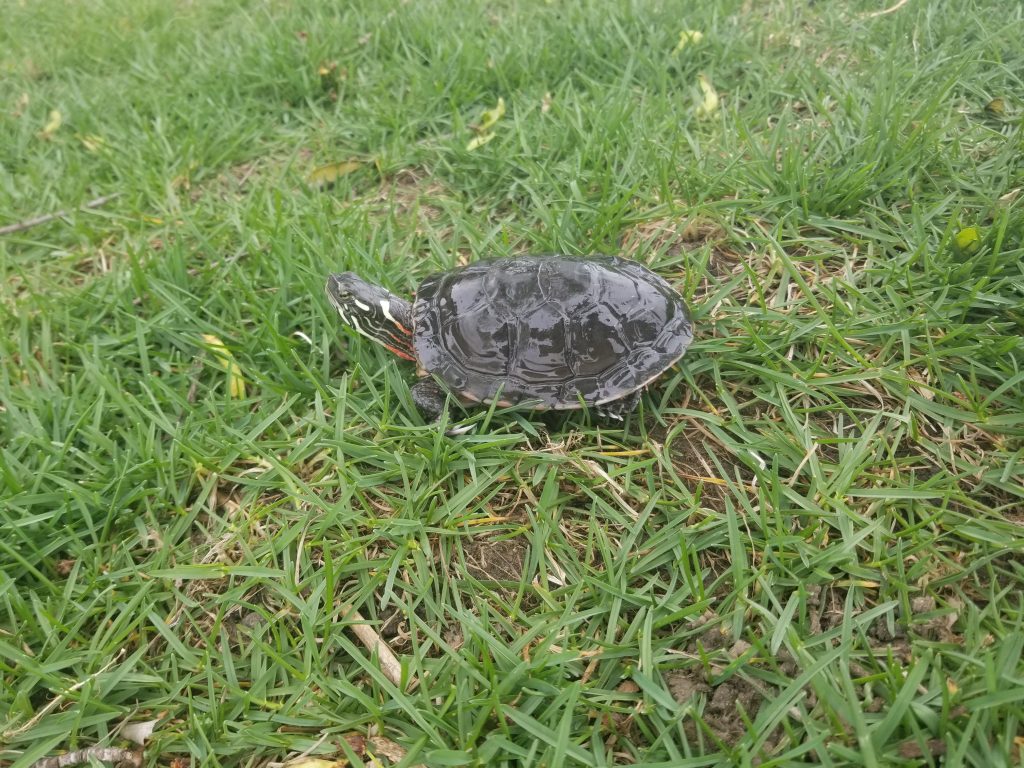Welcome!
Let me be the first to congratulate you on joining the Street Turtle Rescue Squad. The Street Turtle Rescue Squad, or STRS, is an elite team of wildlife rescue personnel completely and solely dedicated to serving the turtle population in your neighborhood. Our work is vital. Without the heroic efforts of the Street Turtle Rescue Squad, helpless, slow-moving turtles would be in mortal danger every time they crossed a road. This STRS new recruit training manual will give you all the information you need to begin your work as a Street Turtle Rescuer.
Why Did the Turtle Cross the Road?
 The first step in your training is to understand the thoughts of the travel-minded turtle. Turtles typically hit the road between April and October. During the Spring months, male turtles are on the prowl for female turtles and female turtles are searching for ideal nesting spots. Roads are simply obstacles in the paths of these hormone-driven turtles.
The first step in your training is to understand the thoughts of the travel-minded turtle. Turtles typically hit the road between April and October. During the Spring months, male turtles are on the prowl for female turtles and female turtles are searching for ideal nesting spots. Roads are simply obstacles in the paths of these hormone-driven turtles.
There are, however, two other reasons why turtles are attracted to roadways. First, the black asphalt of the road absorbs the heat of the sun. The cold-blooded turtles like to warm themselves on the roads. Second, the loose dirt on the sides of the road offer welcoming nesting spots for female turtles looking for a place to lay her eggs. All this means that you will most likely encounter turtles in the roadways during your patrols.
First Rule of Street Turtle Rescue – Safety
Your safety is the primary concern of the Street Turtle Rescue Squad leaders. We know that saving turtles is dangerous, yet important work, but that work comes second to your own personal safety. Before you eagerly jump into the path of danger, make sure the situation is safe for you and your vehicle. Pull completely off the road, if possible, and turn on your hazard lights to alert passing motorists to your activities. It would be a good idea to have a safety orange or reflective vest in your car that you can don while doing your rescue work. If possible, try to exit your vehicle from the side of the car furthest from the road. And, of course, always keep an eye out for cars.
Rule Two – Assess the Turtle
Once you have located a turtle in the road and have determined it is safe to approach it, do a visual assessment of the turtle. Does it appear to be injured? Look for blood, cracks in its shell, or other signs of injury. If you believe that the animal is injured, immediately contact a wildlife rehabilitator and alert them to your location.
Step Three – To Move or Not to Move, That is the Question
If you have determined that the turtle is not injured, your task is to keep it that way. To do that, the turtle must not be in the road where it can get hit by a speeding car. Now you have a choice. You can either move the turtle, or stand guard while it moves itself across the street.
If it is a busy road, you may want to hurry the turtle along by picking it up and carrying it to the side of the road. ALWAYS, move the turtle in the direction it was travelling. That turtle has places to be, and if you turn him around, he will probably just try to cross the street again as soon as you leave.
When you pick up a turtle, put your hand on top of its shell and place your thumb and index finger on either side of the shell, behind its front legs. Most likely, the turtle will duck into its shell as you pick it up. Some feisty turtles, however, may kick at you with their back legs. Keep a firm grip so you don’t drop it. Also, carry the turtle low to the ground, stooping over as you walk with it, so if you do drop it, it won’t fall very far.
Place the turtle well off the road way, still facing in its original direction and step back for a few moments. Make sure it doesn’t turn around and step into the roadway again.
 If the road is not a well-travelled one, or if the turtle is a snapping turtle, your best bet may be to not move it yourself. You could just stand guard as the turtle does its own thing, serving as a crossing guard of sorts. Or there are a few things you can do to hurry the slow-poke along. You can use a blunt stick to prod the turtle from behind. Do not use a sharp, pointy stick as this may injure the turtle. If you still have your ice scrapper in your car from the winter months, that doubles as an excellent turtle prodder. Gently push the backside of the turtle to get it moving. If you have no stick or ice scrapper to use, you can try stomping your feet on the ground directly behind the turtle. The sound and the vibration are both perceived as threatening to a turtle and it will likely scurry along faster.
If the road is not a well-travelled one, or if the turtle is a snapping turtle, your best bet may be to not move it yourself. You could just stand guard as the turtle does its own thing, serving as a crossing guard of sorts. Or there are a few things you can do to hurry the slow-poke along. You can use a blunt stick to prod the turtle from behind. Do not use a sharp, pointy stick as this may injure the turtle. If you still have your ice scrapper in your car from the winter months, that doubles as an excellent turtle prodder. Gently push the backside of the turtle to get it moving. If you have no stick or ice scrapper to use, you can try stomping your feet on the ground directly behind the turtle. The sound and the vibration are both perceived as threatening to a turtle and it will likely scurry along faster.
It is important to remember to only move the turtle to the side of the road. Never put it in your car and attempt to relocate it to a “safer” place. Doing so will have a devastating impact on the turtle’s psyche. Turtles have a home range and will spend their entire lives in a relatively small area. If you move them even just a few miles away, the turtle will make it its mission to return to its home range. This may mean additional road crossings. Sadly, if a turtle cannot find its way back home, it loses its purpose in life. Depressed, many simply stop eating. Others just wander aimlessly until they die. For the psychological health of the turtle, never remove it from its home range.
Lastly, Don’t Keep the Turtle
Removing any wild animal from its natural habitat and keeping it as a pet is unethical, illegal, and simply wrong. Yes, turtles are cute, but they are also wild animals and should stay that way. Never keep a wandering street turtle as a pet. No matter how much you love it, it will be sad and will long for its home range. Instead, settle for taking a selfie with the street turtles you rescue…safely, of course. Pick out a funny name for it and post the pics to Facebook and Instagram for all your friends to see. Add a clever hashtag so the pic goes viral. Then say farewell to the turtle as you safely move it to the side of the road.
Now that you have been fully trained in the techniques of street turtle rescue, you are ready to start your duties. Drive slowly and safely along back country roads, near swamps and streams, and you will eventually be rewarded with a wayward turtle in need of your help to safely cross the road.
Source:
Cotroneo, Christian. “What To Do If You See a Turtle Crossing the Road.” The Dodo. 21 June 2016. Web. 4 May 2018.
Lowe, Heather. “How to Help Turtles.” Turtle Survival Alliance. Web. 4 May 2018.
“Turtle in the Road – What Should I Do?” Turtle Rescue League. Web. 4 May 2018.

